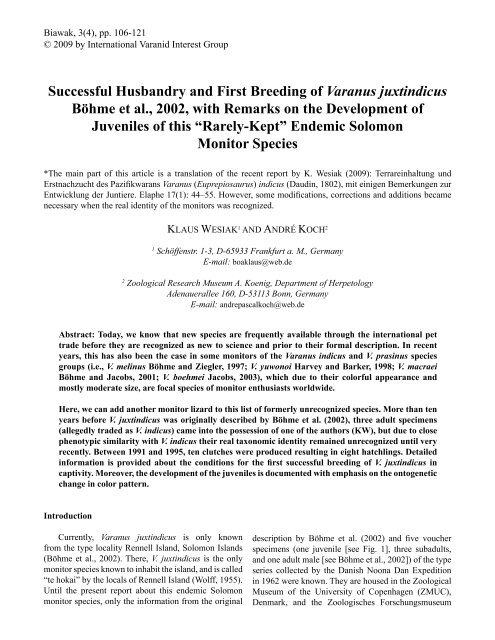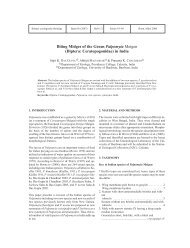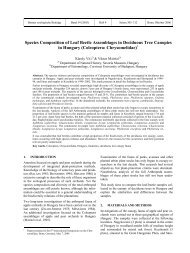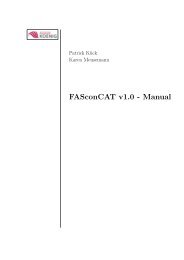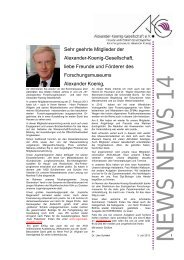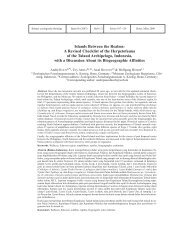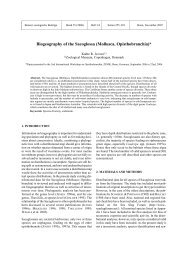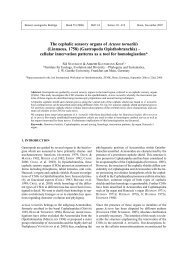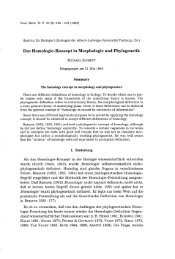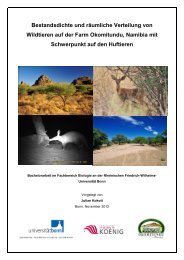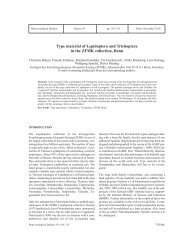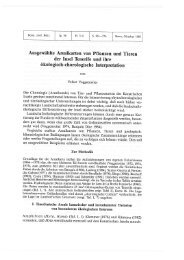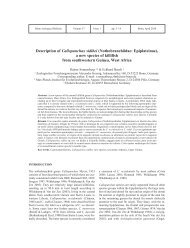Successful Husbandry and First Breeding of Varanus juxtindicus ...
Successful Husbandry and First Breeding of Varanus juxtindicus ...
Successful Husbandry and First Breeding of Varanus juxtindicus ...
Create successful ePaper yourself
Turn your PDF publications into a flip-book with our unique Google optimized e-Paper software.
Biawak, 3(4), pp. 106-121<br />
© 2009 by International Varanid Interest Group<br />
<strong>Successful</strong> <strong>Husb<strong>and</strong>ry</strong> <strong>and</strong> <strong>First</strong> <strong>Breeding</strong> <strong>of</strong> <strong>Varanus</strong> <strong>juxtindicus</strong><br />
Böhme et al., 2002, with Remarks on the Development <strong>of</strong><br />
Juveniles <strong>of</strong> this “Rarely-Kept” Endemic Solomon<br />
Monitor Species<br />
*The main part <strong>of</strong> this article is a translation <strong>of</strong> the recent report by K. Wesiak (2009): Terrareinhaltung und<br />
Erstnachzucht des Pazifikwarans <strong>Varanus</strong> (Euprepiosaurus) indicus (Daudin, 1802), mit einigen Bemerkungen zur<br />
Entwicklung der Juntiere. Elaphe 17(1): 44–55. However, some modifications, corrections <strong>and</strong> additions became<br />
necessary when the real identity <strong>of</strong> the monitors was recognized.<br />
KLAUS WESIAK 1 AND ANDRÉ KOCH 2<br />
1 Schöffenstr. 1-3, D-65933 Frankfurt a. M., Germany<br />
E-mail: boaklaus@web.de<br />
2 Zoological Research Museum A. Koenig, Department <strong>of</strong> Herpetology<br />
Adenauerallee 160, D-53113 Bonn, Germany<br />
E-mail: <strong>and</strong>repascalkoch@web.de<br />
Abstract: Today, we know that new species are frequently available through the international pet<br />
trade before they are recognized as new to science <strong>and</strong> prior to their formal description. In recent<br />
years, this has also been the case in some monitors <strong>of</strong> the <strong>Varanus</strong> indicus <strong>and</strong> V. prasinus species<br />
groups (i.e., V. melinus Böhme <strong>and</strong> Ziegler, 1997; V. yuwonoi Harvey <strong>and</strong> Barker, 1998; V. macraei<br />
Böhme <strong>and</strong> Jacobs, 2001; V. boehmei Jacobs, 2003), which due to their colorful appearance <strong>and</strong><br />
mostly moderate size, are focal species <strong>of</strong> monitor enthusiasts worldwide.<br />
Here, we can add another monitor lizard to this list <strong>of</strong> formerly unrecognized species. More than ten<br />
years before V. <strong>juxtindicus</strong> was originally described by Böhme et al. (2002), three adult specimens<br />
(allegedly traded as V. indicus) came into the possession <strong>of</strong> one <strong>of</strong> the authors (KW), but due to close<br />
phenotypic similarity with V. indicus their real taxonomic identity remained unrecognized until very<br />
recently. Between 1991 <strong>and</strong> 1995, ten clutches were produced resulting in eight hatchlings. Detailed<br />
information is provided about the conditions for the first successful breeding <strong>of</strong> V. <strong>juxtindicus</strong> in<br />
captivity. Moreover, the development <strong>of</strong> the juveniles is documented with emphasis on the ontogenetic<br />
change in color pattern.<br />
Introduction<br />
Currently, <strong>Varanus</strong> <strong>juxtindicus</strong> is only known<br />
from the type locality Rennell Isl<strong>and</strong>, Solomon Isl<strong>and</strong>s<br />
(Böhme et al., 2002). There, V. <strong>juxtindicus</strong> is the only<br />
monitor species known to inhabit the isl<strong>and</strong>, <strong>and</strong> is called<br />
“te hokai” by the locals <strong>of</strong> Rennell Isl<strong>and</strong> (Wolff, 1955).<br />
Until the present report about this endemic Solomon<br />
monitor species, only the information from the original<br />
description by Böhme et al. (2002) <strong>and</strong> five voucher<br />
specimens (one juvenile [see Fig. 1], three subadults,<br />
<strong>and</strong> one adult male [see Böhme et al., 2002]) <strong>of</strong> the type<br />
series collected by the Danish Noona Dan Expedition<br />
in 1962 were known. They are housed in the Zoological<br />
Museum <strong>of</strong> the University <strong>of</strong> Copenhagen (ZMUC),<br />
Denmark, <strong>and</strong> the Zoologisches Forschungsmuseum
Fig. 1. Juvenile paratype <strong>of</strong> <strong>Varanus</strong> <strong>juxtindicus</strong> (ZMUC E617), dorsal (A) <strong>and</strong> ventral side (B). Photographs by<br />
Mogens Andersen.<br />
Alex<strong>and</strong>er Koenig (ZFMK), Bonn, Germany (Böhme<br />
et al., 2002). Thus, V. <strong>juxtindicus</strong> has to be regarded<br />
as one <strong>of</strong> the least known <strong>and</strong> rarest monitor species<br />
<strong>of</strong> the world (Böhme et al., 2004). Due to its assumed<br />
close relationship <strong>and</strong> phenotypic similarity with the<br />
widespread mangrove monitor (V. indicus) consisting<br />
<strong>of</strong> a dark background coloration mottled with numerous<br />
yellow scales, V. <strong>juxtindicus</strong> obtained its scientific<br />
species name (from Latin iuxta = “next to” or “close<br />
to”). The species is distinguished from all other members<br />
<strong>of</strong> the V. indicus species group (V. caerulivirens, V.<br />
cerambonensis, V. doreanus, V. finschi, V. indicus, V.<br />
jobiensis, V. lirungensis, V. melinus, V. rainerguentheri,<br />
V. yuwonoi, <strong>and</strong> V. zugorum) by its tail shape (Fig. 2),<br />
which is roundish in its first third <strong>and</strong> lacks a differentiated<br />
double keel on its dorsal ridge (Böhme et al., 2002).<br />
Fig. 2. Characteristic for V. <strong>juxtindicus</strong>: the tail lacks<br />
a distinct dorsal double keel. Photograph by André<br />
Koch.<br />
BIAWAK VOL. 3 NO. 4<br />
A B<br />
107<br />
A photograph <strong>of</strong> a juvenile V. <strong>juxtindicus</strong> (Fig. 3)<br />
taken by Gunther Köhler (Frankfurt) from the <strong>of</strong>fspring<br />
<strong>of</strong> Klaus Wesiak (KW) was published more than ten<br />
years ago in Bennett (1996: 203; 1998: 191) <strong>and</strong> again in<br />
Eidenmüller (1997: 64). In Bennett (1998: 124), another<br />
specimen bred by KW is shown at the age <strong>of</strong> one <strong>and</strong> a<br />
half years (photograph by Felix Hulbert). Remarkably,<br />
the color pattern <strong>of</strong> this specimen is very bright yellowishgreen<br />
(Fig. 4). While the lack <strong>of</strong> the characteristic dorsal<br />
double keel as typical for V. <strong>juxtindicus</strong> is hardly visible<br />
in the juvenile specimen mentioned above, the tail <strong>of</strong> the<br />
adult specimen is obviously roundish <strong>and</strong> not laterally<br />
compressed. However, this confusion seems to have not<br />
Fig. 3. Juvenile V. <strong>juxtindicus</strong>. Photograph by Gunther<br />
Köhler.
108<br />
WESIAK AND KOCH - HUSBANDRY AND BREEDING OF VARANUS JUXTINDICUS<br />
Fig. 4. Subadult captive-bred V. <strong>juxtindicus</strong> at the age <strong>of</strong> one <strong>and</strong> a half years. Note the very bright yellowish-green<br />
pattern <strong>of</strong> this specimen. Photograph by Felix Hulbert.<br />
been recognized by any reader <strong>of</strong> Bennett’s (1998) book<br />
since the publication by Böhme et al. (2002).<br />
In light <strong>of</strong> these findings, photographs <strong>of</strong> real<br />
mangrove monitors (V. indicus sensu stricto) in the<br />
varanid literature are indeed quite rare. The real identity<br />
<strong>of</strong> these specimens has been unrecognized for so long<br />
(actually since at least 1962) due to the high degree <strong>of</strong><br />
external similarity between V. indicus <strong>and</strong> V. <strong>juxtindicus</strong>,<br />
its sibling species from the Solomon Isl<strong>and</strong>s.<br />
After several new descriptions within the V. indicus<br />
species complex during the last several years, the<br />
taxonomic identity <strong>of</strong> the monitors had to be checked.<br />
Wolfgang Böhme <strong>and</strong> AK (both ZFMK) identified<br />
the species based on photographic evidence <strong>and</strong> two<br />
specimens (Figs. 2 <strong>and</strong> 5) from the private collection<br />
<strong>of</strong> Florian Wagner (Frankfurt), which were said to be<br />
<strong>of</strong>fsprings <strong>of</strong> KW’s monitors. Both <strong>of</strong> these specimens<br />
were donated to the Museum Alex<strong>and</strong>er Koenig in<br />
Bonn shortly after their death in 2009. In addition to the<br />
relatively brief report about the first <strong>of</strong>fspring <strong>of</strong> <strong>Varanus</strong><br />
(juxt)indicus (Wesiak, 1993a, b), some basic data are<br />
provided in the present paper in retrospect about the<br />
eight-fold successful breeding <strong>of</strong> V. <strong>juxtindicus</strong> between<br />
1993 <strong>and</strong> 1996.<br />
Structure <strong>of</strong> the <strong>Breeding</strong> Group<br />
In summer 1989, KW purchased an adult female V.<br />
<strong>juxtindicus</strong> <strong>of</strong> about 100 cm total length from the pet<br />
trade, legally imported from the Solomon Isl<strong>and</strong>s. After<br />
treatment for parasitic nematodes <strong>and</strong> flagellates <strong>of</strong><br />
the intestinal tract, the initial condition <strong>of</strong> the monitor<br />
changed for the best <strong>and</strong> it grew to a total length <strong>of</strong> 110<br />
cm within the next year.<br />
In autumn 1990, five adult specimens that had<br />
been illegally imported <strong>and</strong> confiscated by the German<br />
customs were conveyed to KW by the Bundesamt für<br />
Ernährung und Forstwirtschaft (Federal Office for<br />
Nutrition <strong>and</strong> Forestry). One male <strong>and</strong> two females<br />
<strong>of</strong> about 100 cm total length each showed differences<br />
in color <strong>and</strong> pattern towards the previously-received<br />
female, but were similar in their appearance among<br />
each other. The two remaining males <strong>of</strong> 100 <strong>and</strong> 130<br />
cm total length (Fig. 6), respectively, were identical in<br />
their habitus with the female (Figs. 7 <strong>and</strong> 8). All five<br />
monitors were in poor condition; their feces were thin<br />
<strong>and</strong> ensanguined caused by various endoparasites. The<br />
two latter males showed advanced symptoms. After<br />
multiple treatments for nematodes, cestodes, flagellates,<br />
<strong>and</strong> Entamoeba invadens by Dr. G. Köhler, Offenbach,<br />
their physical condition <strong>and</strong> behavior had normalized.<br />
No parasites were detected in all fecal samples.<br />
After all monitors had been kept together for some<br />
weeks, the three specimens with differing color <strong>and</strong><br />
patterns were passed on to a monitor keeper colleague<br />
(the male specimen is depicted in Eidenmüller [2003: 31,<br />
76]). Unfortunately, they did not breed there. Both large<br />
males quickly grew to 135 cm <strong>and</strong> 140 cm total length,<br />
respectively, <strong>and</strong> were brought together permanently<br />
with the suitable female in February 1991.
Fig. 5. Portrait <strong>of</strong> V. <strong>juxtindicus</strong>, which is said to be from the <strong>of</strong>fspring <strong>of</strong> KW’s monitor specimens. Photograph by<br />
André Koch.<br />
Fig. 6. An adult male V. <strong>juxtindicus</strong> climbing on a branch.<br />
Photograph by Klaus Wesiak.<br />
Fig. 7. Female monitor leaving the box after egg<br />
deposition. Note the specimen’s dark anterior third <strong>of</strong><br />
the tongue. Photograph by Klaus Wesiak.<br />
BIAWAK VOL. 3 NO. 4<br />
Fig. 8. The adult female V. <strong>juxtindicus</strong> with intensive<br />
yellow mottling. Photograph by Klaus Wesiak.<br />
109
110<br />
Housing<br />
WESIAK AND KOCH - HUSBANDRY AND BREEDING OF VARANUS JUXTINDICUS<br />
The long-term <strong>and</strong> species-appropriate keeping<br />
<strong>and</strong> breeding <strong>of</strong> medium-sized to large monitor species<br />
is a fixed element in herpetoculture in most zoos <strong>and</strong><br />
some private households. Recent advances in light <strong>and</strong><br />
heating technique as well as knowledge about dietary<br />
requirements, particularly nutrition supplements, <strong>and</strong><br />
comprehensive veterinary support are the basis for a<br />
healthy <strong>and</strong> long life in captivity. For a comprehensive<br />
overview on published breeding results we refer, for<br />
instance, to Horn & Visser (1989, 1997) as well as to<br />
the references in Bennett (1996, 1998), Kirschner et al.<br />
(1996), <strong>and</strong> Eidenmüller (1997, 2003).<br />
The respectable body dimensions <strong>of</strong> V. <strong>juxtindicus</strong><br />
together with their strength <strong>and</strong> activity disallow the<br />
use <strong>of</strong> st<strong>and</strong>ard silicon terraria made <strong>of</strong> glass. Instead,<br />
the spacious terrarium has to be ordered or home-made<br />
following an elaborate concept. With respect to the<br />
individual structural elements <strong>of</strong> the apartment, the<br />
terrarium required a lightweight construction <strong>of</strong> robust,<br />
non-corrosive materials such as breeze blocks <strong>and</strong><br />
aluminum pr<strong>of</strong>iles to fix the glass plates (Fig. 9). The<br />
walls <strong>and</strong> flooring were covered with plaster cement <strong>and</strong><br />
synthetic resin (for a detailed description we refer to<br />
Wesiak [1996] <strong>and</strong> Wilms [2004]). Sliding glass doors<br />
are unsuitable, lockable glass doors are preferable. The<br />
more entries the terrarium has, the more effective it is<br />
to work inside. A large water feature was mounted at<br />
the bottom <strong>of</strong> the terrarium. A water inlet <strong>and</strong> waste<br />
pipe (leading directly into the sewer) was operable from<br />
Fig. 9. Terrarium in the former collection <strong>of</strong> KW for<br />
keeping large monitor species like V. <strong>juxtindicus</strong>.<br />
Photograph by Klaus Wesiak.<br />
outside the terrarium. A second, smaller terrarium with<br />
the same structure was indispensable to separate the<br />
females during gestation, egg deposition, <strong>and</strong> directly<br />
afterwards for recovery. The terrarium built in the corner<br />
<strong>of</strong> the room was pentagonal with a an area <strong>of</strong> about 3.75<br />
m 2 including the water feature <strong>and</strong> a height <strong>of</strong> 1.1 meters<br />
in front <strong>and</strong> 1.25 meters in the rear areas.<br />
Geographically relevant data about climate was taken<br />
from literature sources (e.g., Brockhaus 1982). <strong>Varanus</strong><br />
<strong>juxtindicus</strong> was kept perennially at high temperatures (27°<br />
to 30° C air temperature, water temperature not below<br />
27°C) <strong>and</strong> high relative air humidity. Water temperature<br />
did not decrease at night, because these monitors <strong>of</strong>ten<br />
used the water pond to sleep. A thermostat-regulated<br />
freezer protection <strong>of</strong> 400 W placed below the terrarium<br />
was used to warm the terrarium’s ground, air <strong>and</strong> water.<br />
The temperature sensor was supsended from the ceiling<br />
<strong>and</strong> inaccessible for the monitors.<br />
The enclosure’s artificial lighting was provided by<br />
four fluorescent lambs (36 W) which corresponded to the<br />
natural spectrum <strong>of</strong> sunlight. In addition, the monitors<br />
needed a place to warm-up, with local temperatures <strong>of</strong><br />
40° to 45°C combined with an UV ray lamp because they<br />
regularly spent long periods under the radiation source<br />
(Horn in Sauer et al., 2004; Böttcher, 2007; Lehmann,<br />
2007). One 120 W spot (from Osram) provided light<br />
<strong>and</strong> heat all day, while a 300 W Ultra Vitalux spot (also<br />
from Osram) was added two times per day for 45 min<br />
each in the morning <strong>and</strong> the afternoon. All electrical<br />
components <strong>and</strong> connections were out <strong>of</strong> reach from the<br />
monitors.<br />
Initial Quarantine<br />
Like other members <strong>of</strong> the V. indicus species group,<br />
which forage in mangrove swamps <strong>and</strong> rainforests<br />
(Philipp, 1999, Ziegler et al, 2001, Philipp et al., 2007),<br />
V. <strong>juxtindicus</strong> is probably an opportunistic predator <strong>and</strong><br />
is probably infested with parasites in the juvenile phase.<br />
Inadequate conditions by ruthless exporters <strong>and</strong> stress<br />
during transportation impair the health <strong>of</strong> monitors.<br />
Nematodes <strong>and</strong> protozoans (primarily Entamoeba<br />
invadens) in the intestinal tract, <strong>and</strong> nematodes <strong>and</strong><br />
pentastomes in the lungs cause severe inflammations <strong>of</strong><br />
the organs as secondary infections, generally with fatal<br />
consequences. These parasites are highly infectious <strong>and</strong><br />
can achieve epidemic proportions.<br />
Recently imported monitors were placed separately<br />
in quarantine. For feeding <strong>and</strong> cleaning, each terrarium<br />
had its own set <strong>of</strong> tools. Newspaper was used as substrate;<br />
excrement was immediately removed <strong>and</strong> the newspaper
eplaced. After working in a quarantine terrarium, h<strong>and</strong>s<br />
<strong>and</strong> tools were thoroughly washed <strong>and</strong> disinfected.<br />
Water taps <strong>and</strong> the soap dispenser were only touched<br />
with the elbows. These surgical hygienic procedures<br />
always accompanied veterinary treatments such as<br />
the analysis <strong>of</strong> multiple fecal samples. After treatment<br />
with anti-parasitic medication, the monitors remained<br />
in quarantine for a minimum eight week period. For<br />
better control, several fecal samples were reanalyzed<br />
some weeks later. Procedures for wild caught monitors<br />
were the same irrespective <strong>of</strong> whether they were recent<br />
imports or long term captives.<br />
Against nematodes, Panacur® (active substance is<br />
Fenbendazole, dose: 70 mg/kg) from Hoechst AG, now<br />
Aventis S.A., was given once orally. Treatment was<br />
repeated after two weeks. Against cestodes, Droncit®<br />
(Praziquantele, dose: 15-20 mg/kg) was given according<br />
to the medication as explained before. Against flagellates,<br />
Duodegran® (Ronidazol, dose: 10 mg/kg each day,<br />
not available anymore, today’s equivalent is Ridzol®,<br />
same active substance from the company Dr. Hesse<br />
Tierpharma GmbH & Co. KG) was dissolved with water<br />
<strong>and</strong> administered daily with a stomach tube over a period<br />
<strong>of</strong> 10 days. Against Entamoeba invadens, Resochin®<br />
(active substance Chloroquin) was provided over a<br />
period <strong>of</strong> 8 days according to the following protocol:<br />
<strong>First</strong> day 0.6 ml/kg (equivals 18 mg/kg), second day<br />
0.8 ml/kg (equivals 24 mg/kg), third day same dose as<br />
previous day, fourth day 1.0 ml/kg (equals 30 mg/kg),<br />
fifth day same dose as previous day, sixth day 0.8 ml/kg,<br />
<strong>and</strong> seventh day 0.6 ml/kg again. After this treatment, a<br />
test for antibiotic resistance was conducted. As a result,<br />
bacterial infections were medicated with Vibramycin®<br />
(Doxycycline). Nothing was done against pentastomes<br />
in the hope that these parasites <strong>of</strong> the respiratory<br />
system would not cause any complications. Eggs were<br />
only detectable in the feces <strong>of</strong> both male specimens.<br />
Medications outlined above refer to Frank (1985) <strong>and</strong><br />
Köhler (1993, 1996).<br />
Behavior in the Terrarium<br />
Kept under optimal spatial <strong>and</strong> climatic conditions,<br />
healthy specimens <strong>of</strong> V. <strong>juxtindicus</strong> quickly lost their<br />
initial nervousness <strong>and</strong> displayed their amazing energy<br />
<strong>and</strong> potential speed. Therefore, it was advantageous to<br />
arrange several strong branches in the terrarium <strong>and</strong><br />
to cover the back wall with artificial rockwork. The<br />
monitors used every space <strong>of</strong> the terrarium, either by<br />
climbing or by regular swimming <strong>and</strong> diving (Fig. 10).<br />
The water feature (190 x 105 x 40 cm deep) <strong>of</strong> the large<br />
BIAWAK VOL. 3 NO. 4<br />
111<br />
terrarium was regularly used daily by the monitors.<br />
During their activity period, adult V. <strong>juxtindicus</strong><br />
were surprisingly sociable. Both <strong>of</strong> the large male<br />
specimens mentioned above lived together with the<br />
female for many years in the same terrarium. Conflicts<br />
were never observed. Even during several consecutive<br />
reproductive periods, the males remained calm <strong>and</strong><br />
showed no conspicuous aggressive behavior. During a<br />
seven year period, a single case <strong>of</strong> aggressive behavior<br />
was observed between two females. The quarrel lasted<br />
for some days <strong>and</strong> was confined to aggressive postures<br />
<strong>and</strong> chasing through the terrarium. Injuries did not<br />
occur.<br />
Feeding<br />
In contrast to everyday life, V. <strong>juxtindicus</strong> had to be<br />
carefully observed during feeding. The monitors lunged<br />
quickly at the food <strong>of</strong>fered <strong>and</strong> <strong>of</strong>ten bit around without<br />
control. After having prepared food <strong>and</strong> before opening<br />
the terrarium, h<strong>and</strong>s should be thoroughly washed to<br />
ensure that the monitors could not discern the scent <strong>of</strong><br />
eggs, fish, mice or other potential prey. Long tweezers<br />
were suitable for feeding. When fed small mammals like<br />
mice, the monitors displayed pronounced greediness <strong>and</strong><br />
snapped at the heads <strong>of</strong> conspecifics. Once, a monitor<br />
keeper colleague reported that a specimen <strong>of</strong> V. indicus<br />
died from severe head injuries as the result <strong>of</strong> aggressive<br />
biting during feeding with mice. The only correct <strong>and</strong><br />
secure procedure was to separate the monitors before<br />
feeding. Due to this procedure, none <strong>of</strong> the V. <strong>juxtindicus</strong><br />
in KW’s collection were ever injured during feeding.<br />
Before the monitors were brought together again, their<br />
heads were rinsed with water to remove food remains<br />
Fig. 10. <strong>Varanus</strong> <strong>juxtindicus</strong> frequently used the water<br />
feature for swimming <strong>and</strong> diving. Photograph by Klaus<br />
Wesiak.
112<br />
WESIAK AND KOCH - HUSBANDRY AND BREEDING OF VARANUS JUXTINDICUS<br />
<strong>and</strong> olfactory traces. In addition, it is recommended to<br />
wait until the monitors are completely at ease. This took<br />
about 10 minutes each time.<br />
The high energy dem<strong>and</strong> <strong>of</strong> the monitors could<br />
not be met by feedings only insects. High quality food<br />
with adequate calorie content had to be provided. In<br />
addition to large insects, subadult mice <strong>and</strong> rats, boiled<br />
eggs, crabs, <strong>and</strong> saltwater fish were provided two to<br />
three times per week. Despite the daily UV exposure,<br />
it was necessary to enhance the food with vitamins <strong>and</strong><br />
mineral supplements. Biweekly, higher-concentrated<br />
multivitamin doses (Multi Mulsin® from Mucos<br />
Pharma, now discontinued) were provided. The dose<br />
<strong>of</strong> the supplements used should be 600 I.E. for vitamin<br />
A <strong>and</strong> 100 I.E. for vitamin D 3 per kg/body mass <strong>and</strong><br />
week. The calculation <strong>of</strong> vitamin D 3 dose has priority if<br />
the concentration <strong>of</strong> both vitaminsare not balanced (G.<br />
Köhler, pers. comm.).<br />
Reproduction in Captivity<br />
After two months, first copulations were observed<br />
between 30 March 1991 <strong>and</strong> 6 April 1991 (Fig. 11). The<br />
female only mated with the smaller male which always<br />
alternated use <strong>of</strong> both hemipenes. While approaching,<br />
the male regularly bit the female’s neck which in some<br />
cases was quite fierce. To date, this behavior has not been<br />
observed in any other monitor species kept by KW.<br />
Matings always followed the above described<br />
behaviors. The mean time span between the last mating<br />
<strong>and</strong> oviposition was 40 days. The female regularly<br />
frequented a sunken box with removable cover to deposit<br />
the clutches. The female’s tendency to eat the eggs after<br />
deposition persisted. Even the decision, from January<br />
1995 onwards, to induce oviposition by the application<br />
<strong>of</strong> Oxitocin® (3 I.E/kg body mass intramuscular [Köhler<br />
1996]), could not solve this problem. The number <strong>of</strong><br />
eaten eggs was always verified by the partly digested<br />
eggs in the female’s feces (see Fig. 13).<br />
The first eggs were laid on 15 May 1991 (Fig. 12).<br />
Immediately after deposition (Fig. 8) the female ate<br />
three <strong>of</strong> the four eggs (Fig. 13). The fourth egg proved<br />
to be unfertilized when incubated artificially. By April<br />
1993, the female had deposited two further clutches<br />
(29 October 1992 <strong>and</strong> 18 January 1993) which only<br />
contained five <strong>and</strong> six unfertilized eggs, respectively.<br />
Between April 1993 <strong>and</strong> April 1995, the female laid<br />
another seven clutches. In total, 54 eggs were deposited<br />
(<strong>of</strong> which 24 were eaten) with ten fertilized eggs, eight <strong>of</strong><br />
which were successfully incubated. Initially, Vermiculite<br />
was used as substrate, but was switched to Perlite for later<br />
clutches due to its looser grain. However, no advantage<br />
was recognized.<br />
The first V. <strong>juxtindicus</strong> hatched in captivity on 28<br />
September 1993 (Figs.14 to 16). All eight hatchlings,<br />
without exception, opened <strong>and</strong> left their eggs<br />
independently. A summary <strong>of</strong> the fertilized clutches<br />
between 1993 <strong>and</strong> 1995 (denoted as I to VII) <strong>and</strong> data<br />
on the first phase <strong>of</strong> live juveniles are provided in Table<br />
1.<br />
Fig. 11. Mating <strong>of</strong> the small male <strong>and</strong> the female V.<br />
<strong>juxtindicus</strong>. Photograph by Klaus Wesiak.<br />
Fig. 12. Clutch <strong>of</strong> four eggs <strong>of</strong> V. <strong>juxtindicus</strong>; below an<br />
unfertilized egg. Photograph by Klaus Wesiak.<br />
Fig. 13. Partly digested eggs from the feces <strong>of</strong> the<br />
female. Photograph by Klaus Wesiak.
Table 1. Summary <strong>of</strong> reproduction data for V. <strong>juxtindicus</strong> between 1993 <strong>and</strong> 1995.<br />
Clutch I II III IV V VI VII<br />
Hatchlings spec. 1 - - spec. 2 spec. 3 spec. 4 - spec. 5 spec. 6 spec. 7 spec. 8<br />
Eggs<br />
Deposition Date 06.04.1993 24.07.1993 10.10.1993 13.06.1994 13.06.1994 13.06.1994 20.11.1994 19.01.1995 19.01.1995 19.01.1995 05.4.1995<br />
Oxytocin donated no no no no no no no yes yes yes yes<br />
Number <strong>of</strong> Eggs 5 5 7 6 6 6 6 5 5 5 5<br />
Fertilized Eggs 2 - ? 3 3 3 ? 3 3 3 2<br />
Dead in Egg 1 - - - - - - - - - 1<br />
Hatch Date 28.09.1993 - - 18.11.1994 20.11.1994 20.11.1994 - 04.07.1995 04.07.1995 04.07.1995 22.09.1995<br />
Eggs Eaten by ♀ 3 1 7 3 3 3 6 1 1 1 -<br />
Incubation<br />
BIAWAK VOL. 3 NO. 4 113<br />
Duration (days) 174 - - 158 160 160 - 166 166 166 170<br />
Temperature (°C) 28.5 - - 30 30 30 - 29.5 29.5 29.5 29.5<br />
Substrate Vermiculite - - Vermiculite Vermiculite Vermiculite - Vermiculite Vermiculite Vermiculite Perlite<br />
Hatch Duration (h) 24 - - 36 36 24 - 12 12 24 24<br />
Growth<br />
Umbilicus Closed After (h) 36 - - 48 36 48 - 24 24 48 36<br />
<strong>First</strong> Feedings After (days) 3 - - 3 4 3 - 4 3 3 4<br />
Days Since Hatch Date 46 - - 39 38 37 - 38 36 33 42<br />
1. Sloughing 13.11.1993 - - 27.12.1994 28.12.1994 27.12.1994 - 11.08.1995 09.08.1995 06.08.1995 03.11.1995<br />
Difference (days) 68 - - 64 78 68 - 71 68 73 68<br />
2. Sloughing 20.01.1994 - - 02.03.1995 17.03.1995 06.03.1995 - 21.10.1995 16.10.1995 18.10.1995 12.01.1996<br />
Difference (days) 85 - - 91 79 87 - 84 86 85 87<br />
3. Sloughing 14.04.1994 - - 01.06.1995 04.06.1995 01.06.1995 - 15.01.1996 12.01.1996 13.01.1996 08.04.1996<br />
Difference (days) 159 - - 159 161 156 - 160 161 158 161<br />
4. Sloughing 20.09.1994 - - 07.11.1995 12.11.1995 04.11.1995 - 23.06.1996 21.06.1996 19.06.1996 16.09.1996
114<br />
WESIAK AND KOCH - HUSBANDRY AND BREEDING OF VARANUS JUXTINDICUS<br />
Fig. 14. <strong>First</strong> hatchling <strong>of</strong> V. <strong>juxtindicus</strong> in captivity, 28<br />
September 1993. Photograph by Klaus Wesiak.<br />
Raising <strong>of</strong> the Juveniles<br />
The umbilicus closed after 24-48 h <strong>and</strong> neonates<br />
began eating after 3-4 days. The juveniles shed their<br />
skin for the first time after 33-46 days, <strong>and</strong> again at<br />
approximately 4, 6, <strong>and</strong> 12 months <strong>of</strong> age (Table 1).<br />
During the first few days, the hatchlings were<br />
housed separately in plastic terraria (ca. 45 x 25 x 30 cm<br />
high), each heated by a heating lamp. The terraria had<br />
a shallow water basin on a bottom covering <strong>of</strong> slightly<br />
Fig. 16. Ventral pattern <strong>of</strong> hatchling. Photograph by<br />
Klaus Wesiak.<br />
Fig. 15. Portrait <strong>of</strong> the first hatchling V. <strong>juxtindicus</strong>.<br />
Photograph by Klaus Wesiak.<br />
humid blotting paper to avoid infections <strong>of</strong> the umbilicus<br />
opening which was not yet closed. When the juveniles<br />
regularly accepted insects as food, they were kept in<br />
glass terraria (ca. 130 x 70 x 90 high), with simple <strong>and</strong><br />
easy to clean furnishings. The largest part was occupied<br />
by the water basin with a water depth <strong>of</strong> ca. 10 cm. The<br />
ground consisted <strong>of</strong> several large stones which poked<br />
out above the water level. Several branches served as<br />
climbing structures. The climate corresponded to the<br />
conditions in the terraria <strong>of</strong> the adult monitors.<br />
The juveniles were <strong>of</strong>fered larger insects such as<br />
grasshoppers, house crickets, Zophobas <strong>and</strong> rose chafer<br />
larvae. In addition, pieces <strong>of</strong> fish <strong>and</strong> naked mice were<br />
also <strong>of</strong>fered. The latter were clearly preferred by the<br />
juveniles. Initially the lizards were fed daily, after four<br />
months they were fed four days per week. During the<br />
first six months, the food was regularly supplemented<br />
with a balanced vitamin <strong>and</strong> mineral product (Korvimin<br />
ZVT® from WDT). Later, concentrated multivitamins<br />
(see above) were provided. The dosage was calculated<br />
as for the adult specimens (see above). Specimens No.<br />
1 <strong>and</strong> No. 8 were each housed separately, the remaining<br />
six specimens <strong>of</strong> clutches IV <strong>and</strong> VI were kept together<br />
for several months in a terrarium. In this situation it<br />
Fig. 17. Two juveniles in their terrarium at the age <strong>of</strong> ca.<br />
six months. The color pattern consists <strong>of</strong> distinct ocelli.<br />
Photograph by Klaus Wesiak.
BIAWAK VOL. 3 NO. 4<br />
Diagram 1. Mean weight gain (g) <strong>of</strong> V. <strong>juxtindicus</strong> <strong>of</strong>fspring (n = 8) during the first year.<br />
Diagram 2. Mean increase in total length (TTL) <strong>of</strong> V. <strong>juxtindicus</strong> <strong>of</strong>fspring (n = 8) during the first year.<br />
115
116<br />
WESIAK AND KOCH - HUSBANDRY AND BREEDING OF VARANUS JUXTINDICUS<br />
Diagram 3. Mean increase in snout-vent length (SVL) <strong>of</strong> V. <strong>juxtindicus</strong> <strong>of</strong>fspring (n = 8) during the first year.<br />
Diagram 4. Mean increase in tail length (TL) <strong>of</strong> V. <strong>juxtindicus</strong> <strong>of</strong>fspring (n = 8) during the first year.
was important to control the feeding because juvenile V.<br />
<strong>juxtindicus</strong> can hurt each other severely. If necessary, the<br />
young monitors were fed separately.<br />
Development <strong>of</strong> the Juveniles<br />
Body Proportions <strong>and</strong> Weight<br />
The development <strong>of</strong> the juveniles during the first year<br />
is documented in Diagrams 1 through 5. As expected,<br />
the increase in body mass showed the highest values<br />
(Diagram 1). While the hatchlings weighed 23.1 g on<br />
average at birth, after a year their weight had increased<br />
by a factor <strong>of</strong> 10. The values <strong>of</strong> the increase in snoutvent<br />
length in all specimens were similar (Diagram 3),<br />
probably because the quantitatively <strong>and</strong> qualitatively<br />
equal food allowance enabled a similar development.<br />
After one year, snout-vent lengths varied between 20.7<br />
<strong>and</strong> 27.4 cm (mean = 24.0 cm). In contrast, the growth<br />
in tail lengths shows a noticeably divergent progress<br />
(Diagram 4), a physiological feature which is apparently<br />
genetically fixed <strong>and</strong> thus not affected by targeted<br />
feeding. In addition, variation in growth rates may be<br />
related to the sex <strong>of</strong> the specimens, but this information<br />
was not available. Correspondingly, the clearly divergent<br />
values <strong>of</strong> the total length are foremost the result <strong>of</strong><br />
the individually divergent increase in tail lengths (see<br />
BIAWAK VOL. 3 NO. 4<br />
117<br />
Diagram 2). Regarding the relation between snout-vent<br />
length <strong>and</strong> tail length, juveniles <strong>of</strong> V. <strong>juxtindicus</strong> hatch<br />
with relatively short tails – common among all monitor<br />
species studied on this variable (Mertens, 1942; Horn<br />
<strong>and</strong> Visser, 1991). The development <strong>of</strong> the head <strong>and</strong><br />
body with the essential organs claims the maximal space<br />
in the egg (Horn <strong>and</strong> Visser, 1991).<br />
Within the first weeks, the relation <strong>of</strong> snout-vent to<br />
tail was clearly shifted in favor <strong>of</strong> tail length (Diagram<br />
5). At six months, the highest relative values loomed<br />
<strong>and</strong>, at the same time, the highest discrepancy between<br />
absolute maximal <strong>and</strong> minimal amount. Up until the first<br />
year, the relative tail length decreased again marginally,<br />
while maximal <strong>and</strong> minimal values approximated<br />
strongly (Diagram 5). At that time, the tail length was<br />
approximately 1.5 times the snout-vent length. This<br />
proportion between tail length <strong>and</strong> snout-vent length<br />
is also found in other monitor species (e.g., V. indicus<br />
<strong>and</strong> V. salvator), which are predominantly terrestrial or<br />
aquatic, while arboreal species have much longer tails<br />
<strong>and</strong> desert species <strong>of</strong>ten have shorter tails (Mertens,<br />
1942; Horn <strong>and</strong> Visser, 1991).<br />
Change in Color Pattern<br />
Dorsally, hatchlings <strong>of</strong> V. <strong>juxtindicus</strong> show a dense<br />
pattern <strong>of</strong> small <strong>and</strong> large whitish spots arranged in<br />
Diagram 5. Increase in mean SVL:TL ratio <strong>of</strong> V. <strong>juxtindicus</strong> <strong>of</strong>fspring (n = 8) during the first year.
118<br />
WESIAK AND KOCH - HUSBANDRY AND BREEDING OF VARANUS JUXTINDICUS<br />
irregular transverse rows on a dark background. On<br />
the tail, the spots form a regular pattern <strong>of</strong> alternating<br />
transverse rows <strong>of</strong> larger <strong>and</strong> smaller spots respectively<br />
(Figs. 3 <strong>and</strong> 14). After the first molting at about two<br />
months, the spots become yellowish on the body.<br />
Laterally on the tail, some scattered ocelli are formed<br />
(Figs. 18A <strong>and</strong> B). Between the second <strong>and</strong> third<br />
molting, at about six months, the yellow coloration on<br />
the head, neck <strong>and</strong> limbs is intensified. On the back<br />
<strong>and</strong> tail, the smaller yellowish spots changed to a faint<br />
pattern <strong>of</strong> turquoise lines <strong>and</strong> distinct ocelli (Figs. 1, 18C<br />
<strong>and</strong> D). The underside <strong>of</strong> the body also showed distinct<br />
ocelli (Fig. 17). After the fourth molting at the age <strong>of</strong><br />
about one year, the head, neck, <strong>and</strong> limbs still exhibit the<br />
brightest colors. The dotted color pattern has changed<br />
into a reticulated yellowish-green pattern interspersed<br />
with black markings (Figs. 19A <strong>and</strong> B). At the age <strong>of</strong><br />
about two years, the juveniles <strong>of</strong> V. <strong>juxtindicus</strong> resemble<br />
the adults. The original color pattern <strong>of</strong> large whitish<br />
spots has dissolved into a homogenous <strong>and</strong> dense<br />
mottling <strong>of</strong> yellowish-green <strong>and</strong> orange small dots on a<br />
dark background. Only along the tail do the small dots<br />
still form thin <strong>and</strong> short transverse bars. The limbs are<br />
covered with yellow scales which have dark margins<br />
(Figs. 19C <strong>and</strong> D).<br />
A B<br />
C<br />
A significant ontogenetic change in color pattern<br />
from juveniles to adults within the same species is<br />
a rather common phenomenon in monitor lizards<br />
(Mertens, 1942). The occupation <strong>of</strong> different ecological<br />
niches during specific life stages within the same habitat<br />
may be responsible for the phenomenon. For instance,<br />
juveniles <strong>of</strong> V. komodoensis Ouwens, 1912 <strong>and</strong> V.<br />
bengalensis (Daudin, 1802) exhibit a vivid pattern<br />
<strong>of</strong> spots. With this camouflaged coloration, juvenile<br />
monitors are predominantly arboreal until they grow<br />
up to avoid pressure by various predators – including<br />
adult conspecifics (Auffenberg, 1981; Karunarathna<br />
et al., 2008). In the case <strong>of</strong> V. <strong>juxtindicus</strong> however, no<br />
statement can be made at the present time for the process<br />
<strong>of</strong> color change due to a lack <strong>of</strong> field observations in the<br />
their natural habitat.<br />
A study about ecological <strong>and</strong> spatial niche<br />
partitioning by Philipp (1999) showed that V. indicus<br />
on New Guinea is not a very specialized species. This<br />
close relative <strong>of</strong> V. <strong>juxtindicus</strong> inhabits mangrove<br />
swamps, costal forests, inl<strong>and</strong> forests along rivers, <strong>and</strong><br />
lower mountain forests. Niche partitioning into different<br />
microhabitats by distinct age groups could not be inferred<br />
in the study area on Irian Jaya, New Guinea (Philipp,<br />
1999).<br />
Fig. 18. Ontogenetic change in color pattern <strong>of</strong> dorsum <strong>and</strong> tail after two (A, B), six (C, D) months. Note the<br />
roundish base <strong>of</strong> the tail lacking a dorsal double keel as characteristic for V. <strong>juxtindicus</strong>. Photographs by Klaus<br />
Wesiak<br />
D
Fig. 19. Ontogenetic change in color pattern <strong>of</strong> dorsum <strong>and</strong> tail after twelve (A, B), <strong>and</strong> twenty-four (C, D) months.<br />
Photographs by Klaus Wesiak.<br />
Outlook<br />
Kok (1993) appears to have been the first person to<br />
breed V. indicus in captivity. He described his experiences<br />
in keeping <strong>and</strong> breeding this species successfully in two<br />
subsequent reports (Kok, 1995a, b). However, it has to be<br />
considered that the adult male specimen with unknown<br />
origin depicted by Kok (1995b) does not represent a<br />
real mangrove monitor (V. indicus s. str.) as defined by<br />
Philipp et al. (1999). It exhibits a thin bright temporal<br />
streak behind the eye, a black <strong>and</strong> white striped tail, <strong>and</strong><br />
a vivid dorsal mottling <strong>of</strong> numerous bright scales on a<br />
dark background. This latter feature strongly resembles<br />
the color pattern characteristic for V. <strong>juxtindicus</strong>, which,<br />
however, lacks the first two characteristics – at least in<br />
adults (Böhme et al., 2002). In addition, the tail <strong>of</strong> Kok’s<br />
male specimen seems to have a typical dorsal caudal<br />
keel as far as it can be determined from the photograph.<br />
Besides the successful breeding <strong>of</strong> V. cf. indicus by<br />
Kok (1993), some further reports about keeping <strong>and</strong><br />
breeding mangrove monitors in captivity have been<br />
published by McCoid (1993), Kukol (1993), Horn <strong>and</strong><br />
Visser (1997), <strong>and</strong> Speer <strong>and</strong> Bayless (2000). While<br />
BIAWAK VOL. 3 NO. 4<br />
A B<br />
C D<br />
119<br />
eggs obtained from captive V. indicus on Guam were<br />
incubated unsuccessfully by McCoid (1993), those<br />
reported by Kukol (1993) seemed not to be fertile. In<br />
addition, by reviewing reproduction data <strong>of</strong> monitor<br />
lizards in captivity, Horn <strong>and</strong> Visser (1997) reported<br />
the unpublished triple breeding success in V. indicus<br />
by two independent keepers (H. Biebl, unpubl. data; S.<br />
Irwin, unpubl. data). Lastly, Speer <strong>and</strong> Bayless (2000)<br />
documented the first case <strong>of</strong> mangrove monitor twins<br />
in what they considered to be V. indicus. In 1996, the<br />
first juvenile hatched (Speer, unpubl. data). Nothing is<br />
mentioned about the fate <strong>of</strong> this specimen. The following<br />
year, twin hatchlings pipped their egg on 13 July 1997,<br />
but did not succeed in emerging from the egg, <strong>and</strong> died<br />
shortly afterwards (Speer <strong>and</strong> Bayless, 2000). Both the<br />
adult specimens <strong>and</strong> the twin hatchlings were depicted in<br />
the short account by Speer <strong>and</strong> Bayless (2000). Similar<br />
to V. <strong>juxtindicus</strong> the male <strong>and</strong> female exhibit a fine<br />
color pattern <strong>of</strong> many bright scales scattered along the<br />
dorsum; the two hatchlings have bright tongue tips <strong>and</strong><br />
lack a distinct caudal keel. For these reasons, we think<br />
that these monitors also belong to V. <strong>juxtindicus</strong>. Another<br />
alleged case <strong>of</strong> reproduction in V. <strong>juxtindicus</strong> occurred in
120<br />
WESIAK AND KOCH - HUSBANDRY AND BREEDING OF VARANUS JUXTINDICUS<br />
1999 but never reached publication (M. Bayless, pers.<br />
comm. to AK).<br />
These few examples demonstrate that the “rarelykept”<br />
V. <strong>juxtindicus</strong> seems to have been quite common<br />
in captivity during the 1990s, long before the taxonomic<br />
distinctness <strong>of</strong> this endemic Solomon monitor species<br />
was recognized (Böhme et al., 2002).<br />
Due to far-reaching changes in the personal<br />
circumstances <strong>of</strong> KW, the keeping <strong>and</strong> breeding <strong>of</strong> V.<br />
<strong>juxtindicus</strong> were ab<strong>and</strong>oned towards the end <strong>of</strong> 1996.<br />
His experiences with this species were very exciting<br />
<strong>and</strong> insightful. He believes that monitors can be kept<br />
<strong>and</strong> bred for a long time in captivity regardless <strong>of</strong> their<br />
size, providing the terrarium is <strong>of</strong> suitable size <strong>and</strong><br />
design, <strong>and</strong> that the keeper is competent <strong>and</strong> has a sense<br />
<strong>of</strong> responsibility. Personally, KW would not avoid the<br />
energy or expense <strong>of</strong> keeping these magnificent <strong>and</strong><br />
vivid monitors again.<br />
Finally, we would like to encourage keepers <strong>of</strong><br />
mangrove monitors <strong>and</strong> its allies, the so-called V. indicus<br />
species group (Ziegler et al., 2007), to publish their<br />
observations <strong>and</strong> experiences with these magnificent<br />
reptiles.<br />
Acknowledgements - We are grateful to Florian Wagner<br />
(Frankfurt) who was the first to draw our attention to the<br />
real identity <strong>of</strong> the monitor specimens under his care,<br />
which in the end turned out to be <strong>Varanus</strong> <strong>juxtindicus</strong>.<br />
Robert Mendyk (New York, USA) pointed our attention<br />
to further reports about reproduction <strong>of</strong> V. “indicus” in<br />
captivity. AK is thankful to the late Mark Bayless who<br />
sent him a draft about the successful breeding <strong>of</strong> what<br />
he thought was V. <strong>juxtindicus</strong>. KW would like to thank<br />
Pr<strong>of</strong>. Dr. Hans-Georg Horn (Sprockhövel) <strong>and</strong> Bernd<br />
Eidenmüller (Frankfurt) for helpful comments on the<br />
draft that was published in Elaphe. B. Eidenmüller<br />
(Frankfurt) also helped to digitally edit some older<br />
slides for the former Elaphe publication. Gunther Köhler<br />
(Senckenberg Museum, Frankfurt) <strong>and</strong> Felix Hulbert<br />
(Eltville) provided some slides <strong>of</strong> KW’s <strong>of</strong>fspring <strong>of</strong> V.<br />
<strong>juxtindicus</strong>. Ulla Bott (ZFMK, Bonn) kindly scanned<br />
them for publication. KW is also grateful to Pr<strong>of</strong>. Dr.<br />
Wolfgang Böhme (ZFMK, Bonn) who kindly helped<br />
to elucidate the identity <strong>of</strong> his monitors. We would like<br />
to stress that Pr<strong>of</strong>. Böhme never saw all pictures <strong>of</strong> the<br />
monitors, nor did he ever see KW’s specimens, until<br />
two adult V. <strong>juxtindicus</strong> were generously donated to the<br />
Museum Alex<strong>and</strong>er Koenig by Florian Wagner.<br />
We apologize for any confusion caused <strong>and</strong> hope<br />
that this translated <strong>and</strong> corrected version <strong>of</strong> the original<br />
article by Klaus Wesiak (2009) will help prevent future<br />
misidentification <strong>of</strong> V. <strong>juxtindicus</strong>. Mogens Andersen<br />
(Zoological Museum <strong>of</strong> the University <strong>of</strong> Copenhagen,<br />
Denmark) kindly provided photographs <strong>of</strong> the juvenile<br />
paratype <strong>of</strong> V. <strong>juxtindicus</strong> for comparisons with the<br />
monitor <strong>of</strong>fspring bred by Klaus Wesiak. Finally, we<br />
thank Wolfgang Böhme (ZFMK), Robert Neal (Brisbane,<br />
Australia), <strong>and</strong> three reviewers for improving the English<br />
language <strong>and</strong> for helpful comments on earlier drafts.<br />
References<br />
Auffenberg, W. 1981. The Behavioral Ecology <strong>of</strong><br />
the Komodo Monitor. University <strong>of</strong> Florida Press,<br />
Gainsville, 406 pp.<br />
Bennett, D. 1996. Warane der Welt, Welt der Warane.<br />
Edition Chimaira, Frankfurt/Main, 383 pp.<br />
Bennett, D. 1998. Monitor Lizards. Natural History,<br />
Biology <strong>and</strong> <strong>Husb<strong>and</strong>ry</strong>. Second edition, Edition<br />
Chimaira, Frankfurt/Main, 352 pp.<br />
Böhme, W., K. Philipp <strong>and</strong> T. Ziegler. 2002. Another<br />
new member <strong>of</strong> the <strong>Varanus</strong> (Euprepiosaurus)<br />
indicus group (Sauria, Varanidae): an undescribed<br />
species from Rennell Isl<strong>and</strong>, Solomon Isl<strong>and</strong>s.<br />
Salam<strong>and</strong>ra 38(1): 15–26.<br />
Böhme, W., K. Philipp <strong>and</strong> T. Ziegler 2004. V.<br />
<strong>juxtindicus</strong>. pp. 193–196 in Pianka, E. R. & D. R.<br />
King (Eds.): Varanoid lizards <strong>of</strong> the world. Indiana<br />
University Press, Bloomington & Indianapolis.<br />
Böttcher, M. 2007. Die Versorgung von Reptilien in<br />
der Terrarienhaltung mit ultraviolettem Licht.<br />
Elaphe 15(1): 32–37.<br />
Brockhaus 1982. Länder und Klima (Asien,<br />
Australien). Brockhaus, Wiesbaden, 240 pp.<br />
Eidenmüller, B. 1997. Warane - Lebensweise, Pflege,<br />
Zucht. Herpeton, Offenbach, 157 pp.<br />
Eidenmüller, B. 2003. Warane - Lebensweise, Pflege,<br />
Zucht. Herpeton, Offenbach, 2. Edition, 176 pp.<br />
Frank, W. 1985. Amphibien und Reptilien. pp.<br />
162–402, In: Isenbügel, E. & W. Frank (Eds.):<br />
Heimtierkrankheiten. Verlag Eugen Ulmer,<br />
Stuttgart, 402 pp.<br />
Horn, H.-G. 2004. Beleuchtung im Vivarium<br />
(Terrarium, Paludarium). pp. 168–253, in: Sauer,<br />
K., B. Steck, H. Schuchart & H.-G- Horn (Eds.):<br />
Praxis Ratgeber Vivarienbeleuchtung. Edition<br />
Chimaira, Frankfurt, 287 pp.<br />
Horn, H.-G. <strong>and</strong> G.-J. Visser. 1989. Review <strong>of</strong><br />
reproduction <strong>of</strong> monitor lizards <strong>Varanus</strong> ssp. in<br />
captivity. International Zoo Yearbook 28: 140–150.
Horn, H.-G. <strong>and</strong> G.-J. Visser. 1991. Basic Data on the<br />
biology <strong>of</strong> monitors. Mertensiella 2: 176–187.<br />
Horn, H.-G. <strong>and</strong> G.-J. Visser. 1997. Review <strong>of</strong><br />
reproduction <strong>of</strong> monitor lizards <strong>Varanus</strong> ssp. in<br />
captivity II. International Zoo Yearbook 35:<br />
227–246.<br />
Karunarathna, S., T. Amarasinghe <strong>and</strong> A. de Voss.<br />
2008. Preliminary notes on the monitor lizards<br />
(Family: Varanidae) within the National Zoological<br />
Garden (NZG) Dehiwala, Colombo District, Sri<br />
Lanka. Biawak 2(3): 109–118.<br />
Kirschner, A., T. Müller <strong>and</strong> H. Seufer.1996.<br />
Faszination Warane. – Kirschner & Seufer Verlag,<br />
Keltern-Weiler, 254 pp.<br />
Köhler, G. 1993. Die Amöbiasis bei Reptilien<br />
– Hinweise zu Pathenogenese, Diagnose und<br />
Therapie. Elaphe 1(4): 15–17.<br />
Köhler, G. 1996. Krankheiten der Amphibien und<br />
Reptilien. Verlag Eugen Ulmer, Stuttgart, 170 pp.<br />
Kok, R. 1993. Gelungene Zucht des Pazifikwarans<br />
(<strong>Varanus</strong> indicus). Monitor 2(2): 31.<br />
Kok, R. 1995a. Weitere Angaben zur wiederholten<br />
Zucht beim Pazifikwaran (<strong>Varanus</strong> indicus).<br />
Monitor 4(1): 39–40.<br />
Kok, R. 1995b. Zur Haltung und Nachzucht des<br />
Pazifikwarans (<strong>Varanus</strong> indicus). Salam<strong>and</strong>ra<br />
31(3): 129–136.<br />
Kukol, Z. 1993. Mangrove monitor, <strong>Varanus</strong> indicus<br />
(Daudin), 1802. Varanews 3: 5.<br />
Lehmann, H.-D. 2007. UV-Bestrahlung im Terrarium<br />
– der Status quo. Elaphe 15(4): 20–30.<br />
McCoid, M.J. 1993. Reproductive output in captive <strong>and</strong><br />
wild mangrove monitors (<strong>Varanus</strong> indicus).<br />
Varanews 3: 4-5.<br />
Mertens, R. 1926. Über die Rassen einiger indoaustralischer<br />
Reptilien. Senckenbergiana 8(5/6):<br />
272–279.<br />
Mertens, R. 1942. Die Familie der Warane (Varanidae),<br />
Teil 1-3. Abh<strong>and</strong>lungen der Senckenbergischen<br />
Naturforschenden Gesellschaft 462, 465, 466:<br />
1–391.<br />
Philipp, K.-M. 1999. Niche partitioning <strong>of</strong> <strong>Varanus</strong><br />
doreanus, V. indicus <strong>and</strong> V. jobiensis in Irian Jaya:<br />
preliminary results. Mertensiella 11: 311–316.<br />
BIAWAK VOL. 3 NO. 4<br />
Received: 28 October 2009; Accepted: 5 December 2009<br />
121<br />
Philipp, K.-M, W. Böhme, <strong>and</strong> T. Ziegler. 1999. The<br />
identity <strong>of</strong> <strong>Varanus</strong> indicus: redifinition <strong>and</strong><br />
description <strong>of</strong> a sibling species coexisting at the<br />
type locality. Spixiana 22: 273–287.<br />
Philipp, K.-M., T. Ziegler <strong>and</strong> W. Böhme. 2007.<br />
Preliminary investigations <strong>of</strong> the natural diet <strong>of</strong> six<br />
monitor lizard species <strong>of</strong> the <strong>Varanus</strong><br />
(Euprepiosaurus) indicus Group. Mertensiella 16:<br />
336–345.<br />
Speer, R.J. <strong>and</strong> M. Bayless. 2000. The first report <strong>of</strong><br />
mangrove monitor twins in captivity: the<br />
remarkable reproduction <strong>and</strong> disappointing result.<br />
Reptiles Magazine 8: 30-31.<br />
Wesiak, K. 1993a. Eine gelungene Nachzucht von<br />
<strong>Varanus</strong> indicus (Daudin 1802). Monitor 2(2): 10.<br />
Wesiak, K. 1993b. Über Haltung und Nachzucht von<br />
<strong>Varanus</strong> (Euprepiosaurus) indicus indicus (Daudin<br />
1802). Herpet<strong>of</strong>auna 15(87): 21–25.<br />
Wesiak, K. 1996. Zum Bau von Aquaterrarien für<br />
großwüchsige Warane. Sauria 18(1): 17–25.<br />
Wesiak, K. 2009. Terrarienhaltung und Erstnachzucht<br />
des Pazifikwarans <strong>Varanus</strong> (Euprepiosaurus)<br />
indicus (Daudin, 1802), mit einigen Bemerkungen<br />
zur Entwicklung der Jungtiere. Elaphe 17(1):<br />
44–55.<br />
Wilms, T. 2004. Terrarieneinrichtung, Grundlagen,<br />
Materialien, Methoden. Natur und Tier-Verlag,<br />
Münster, 128 pp.<br />
Wolff, T. 1955. Rennellese names <strong>of</strong> animals. pp.<br />
59–63 in Wolff, T. (Ed.): The natural history <strong>of</strong><br />
Rennell Isl<strong>and</strong>, British Solomon Isl<strong>and</strong>s. Vol. 1<br />
(vertebrates). Danish Science Press, Copenhagen.<br />
Ziegler, T., W. Böhme, B. Eidenmüller <strong>and</strong> K.-M.<br />
Philipp. 2001. A note on the coexistence <strong>of</strong> three<br />
species <strong>of</strong> Pacific Monitor Lizards in Australia.<br />
Bonner Zoologische Beiträge 50(1/2): 27–30.<br />
Ziegler T., A. Schmitz, A. Koch <strong>and</strong> W. Böhme. 2007.<br />
A review <strong>of</strong> the subgenus Euprepiosaurus <strong>of</strong><br />
<strong>Varanus</strong> (Squamata: Varanidae): morphological <strong>and</strong><br />
molecular phylogeny, distribution <strong>and</strong><br />
zoogeography, with an identification key for the<br />
members <strong>of</strong> the V. indicus <strong>and</strong> the V. prasinus<br />
species groups. Zootaxa 1472: 1–28.


